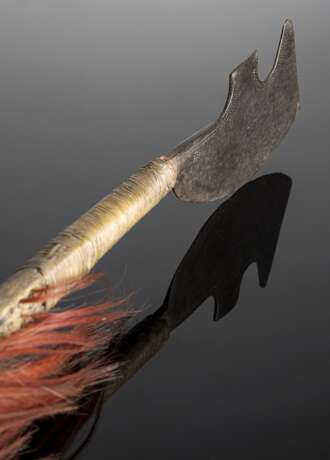ID 1218034
Lot 1517 | Haumesser ''ang dao'' aus Holz mit Ziegenhaar und Rattan
Estimate value
€ 400 – 600
L. 63 cm
Dieses Haumesser mit der kurzen, breiten, im Rücken zweifach konkav eingeschnittenen Klinge vertritt einen sehr seltenen, hoch geachteten Typ des bei den Naga-Gruppen Myanmars, Nordost-Indiens und Assams gängigen Haumessers dao. Die Klinge ist entlang des Rückens punziert, der lange Hartholzgriff mit rot gefärbten Ziegenhaarbüscheln appliziert. Die Handhabe ist mit Rattan umflochten. Dao ist ein aus dem Chinesischen stammender, generischer Name, der Klingen von kleinen Alltagsmessern bis zu großen Ritual- und Statusschwertern abdeckt. Die Form ang dao ist unverkennbar spezifisch für die hochrangigen Mitglieder des heiligen Ang-Clans, von dem sich die großen Stammes-chiefs ableiten. Die Waffe ist eine heilige Requisite. Objekte, die den alten Naga-dao (wie das vorliegende, ang- und milemnok-dao) weitgehend gleichen, finden sich schon an indo-chinesischen Kesseltrommeln der Region des östlichen Himalaya (Heute:Yunnan) des 2. und 3. Jahrhunderts dargestellt. Letztlich gehen sie wohl auf eine Entwicklung aus den chinesischen ge-Klingen zurück. Vom Norden Assams bis in den Süden Burmas und Siams ist das dao ein weit verbreitetes Allzweckwerkzeug, das von der Rasur und dem Haarschnitt bis zum Fällen von Bäumen und dem Verarbeiten von Holz aller Arten und Stärken verwendet wird. Oft ist es neben kleinen Messern das einzige verfügbare Werkzeug. Der Schliff ist stets einseitig gehalten, was der Schneidfähigkeit bei richtigem Gebrauch, nämlich schräg von oben geführten Hieben, entgegenkommt. Das dao wird an starken Rattan- oder Rindenfaser-Gurten im Rücken über dem Gesäß getragen; als Scheide dient ein kastenförmiges Holzelement, das hier fehlt. Naga ist eine ethno-genetische Sammelbezeichnung für über 30 Volksgruppen, der Adivasi, im Nordosten des indischen Subkontinents. Sie verteilen sich auf die heutigen Bundesstaaten Nagaland (seit 1963), Assam, Manipur und Arunachal Pradesh. Ein kleinerer Teil lebt auch in der Sagaing-Region im Nordosten Myanmars.
Aus einer alten deutschen Privatsammlung, seit den 1950er Jahren gesammelt - Minim. Altersspuren, Ziegenhaar partiell verloren
Lit.: P. S. Rawson (1968): The Indian Sword, The Arms & Armor Series, London, S. 58, 64
| Auction house category: | Ethnographic tribal art |
|---|
| Auction house category: | Ethnographic tribal art |
|---|
| Address of auction |
Nagel Auktionen GmbH Neckarstrasse 189 - 191 70190 Stuttgart Germany | ||||||||||||||
|---|---|---|---|---|---|---|---|---|---|---|---|---|---|---|---|
| Preview | |||||||||||||||
| Phone | +49 (0)711 649 690 | ||||||||||||||
| Fax | +49 (0)711 649 69696 | ||||||||||||||
| Buyer Premium | 29,5% | ||||||||||||||
| Conditions of purchase | Conditions of purchase | ||||||||||||||
| Business hours | Business hours
|




